Apologies for posting the same species two days in a row but yesterday I got a grebe twofer – an optical illusion and a behavior I’d never seen before.
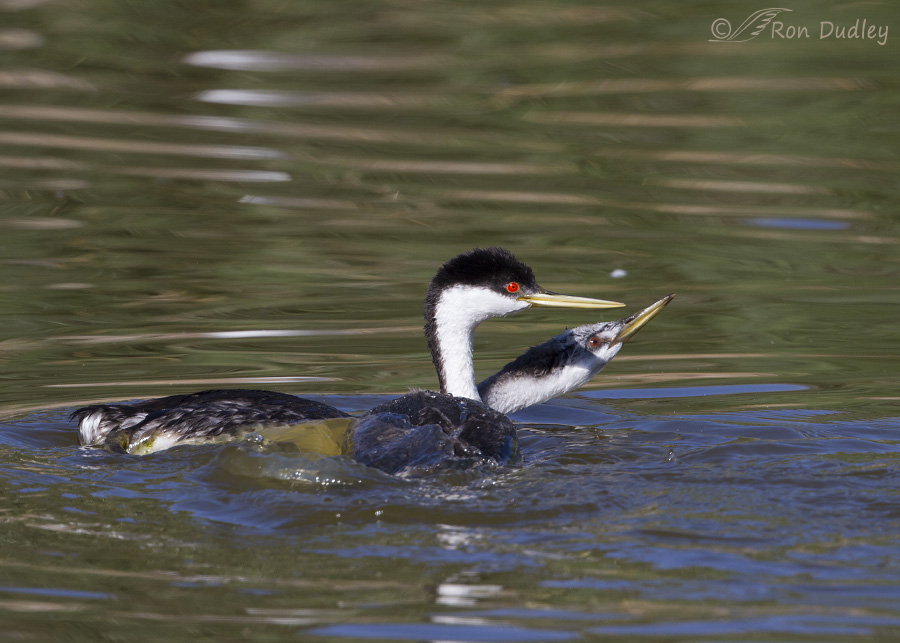
1/2000, f/6.3, ISO 400, Canon 7D, Canon EF 500mm f/4L IS II USM + 1.4 tc, not baited, set up or called in
Ok, first the optical illusion. These are both Western Grebes. The bird with the bright red eye is the parent of the juvenile with the grayish head. The juvenile is almost full-grown and just about the same size as its parent. Please study the image for a few moments and decide what you’re seeing.
It appears (to me at least) that the adult has its back to the viewer and is swimming away from us and directly into the outstretched neck of the juvenile whose body we see lengthwise in the water. But that’s far from the case and I’ll demonstrate that fact by showing you photos of what happened before and after this image was taken.
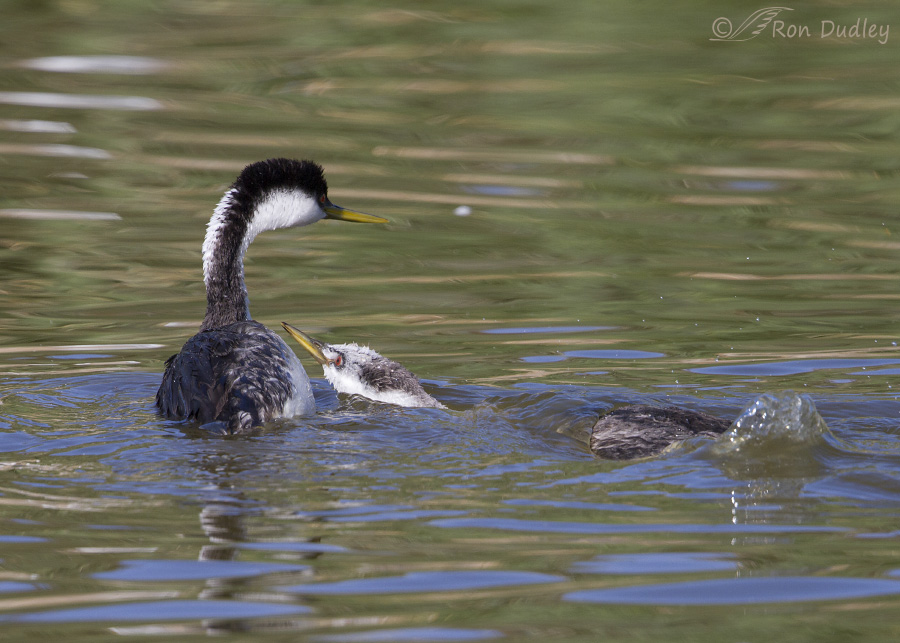
1/2000, f/6.3, ISO 400, Canon 7D, Canon EF 500mm f/4L IS II USM + 1.4 tc, not baited, set up or called in
A few seconds earlier the juvenile swam up to the adult…
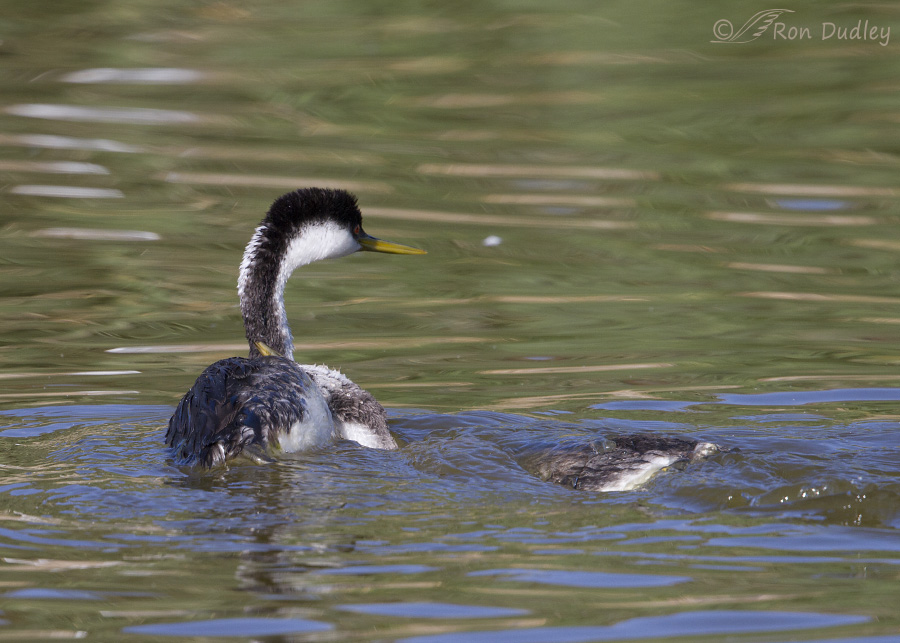
1/2000, f/6.3, ISO 400, Canon 7D, Canon EF 500mm f/4L IS II USM + 1.4 tc, not baited, set up or called in
and began to slide its head over the crook of the neck of its parent.
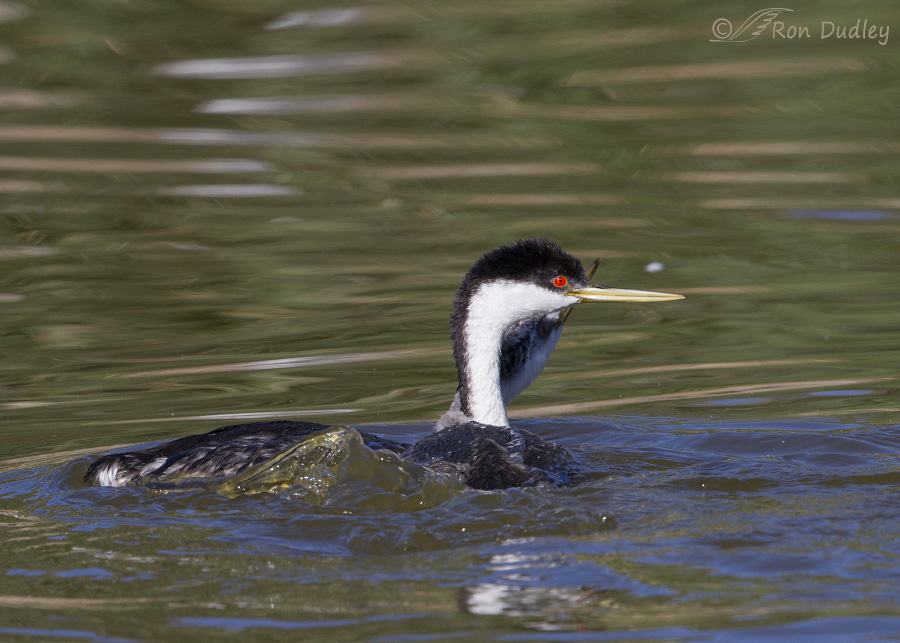
1/2000, f/6.3, ISO 400, Canon 7D, Canon EF 500mm f/4L IS II USM + 1.4 tc, not baited, set up or called in
As both birds turned to my right in the water the youngster continued to swim forward…

1/2000, f/6.3, ISO 400, Canon 7D, Canon EF 500mm f/4L IS II USM + 1.4 tc, not baited, set up or called in
and bend its long neck to the right as its body began to slip over the top of the front of the body of the adult.
This is the image I presented first. Now it should be clear that what we thought we saw in the first image was really an illusion. The body to the left actually belongs to the red-eyed adult.
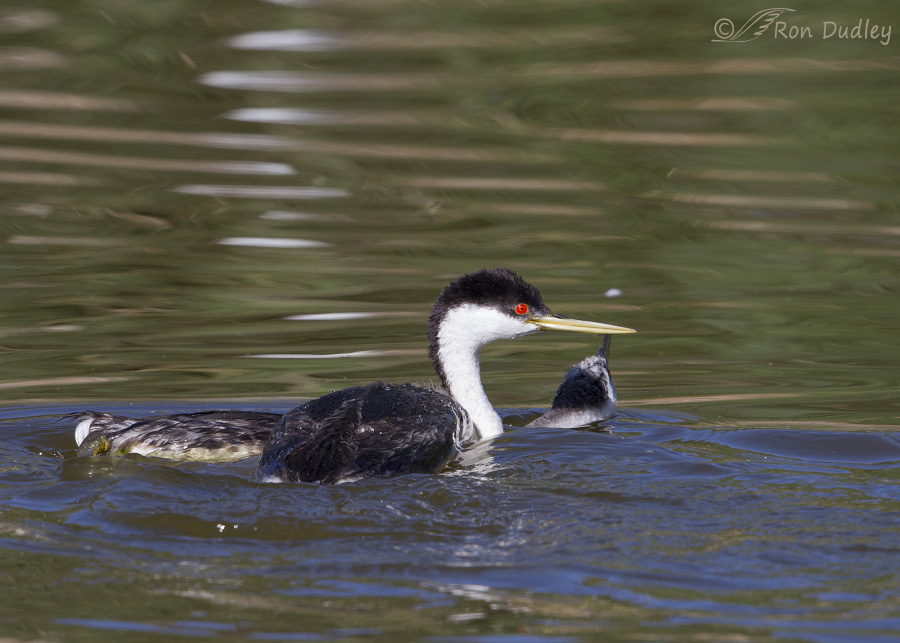
1/2000, f/6.3, ISO 400, Canon 7D, Canon EF 500mm f/4L IS II USM + 1.4 tc, not baited, set up or called in
As the juvenile continued to push forward its body began to go over the top of the adult.
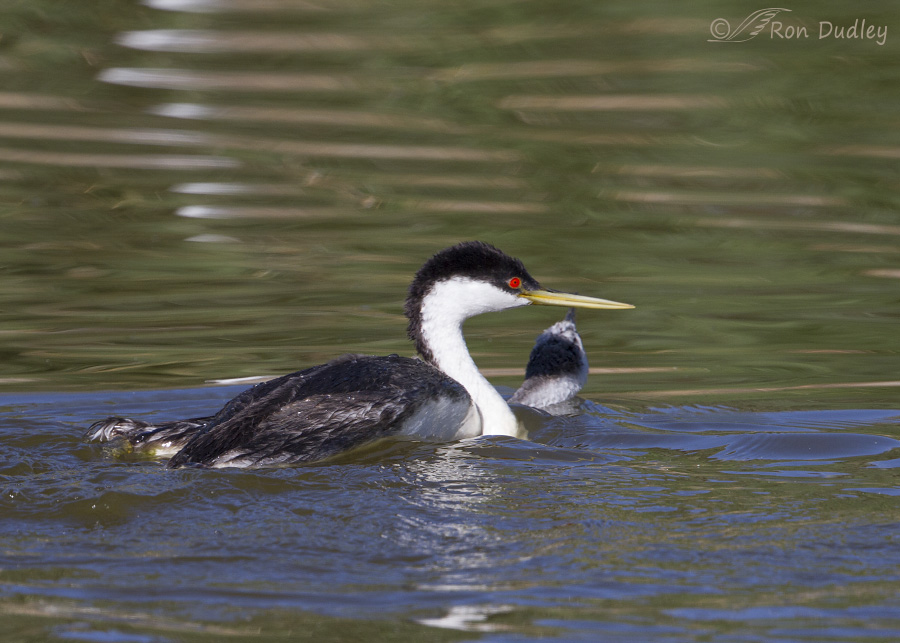
1/2000, f/6.3, ISO 400, Canon 7D, Canon EF 500mm f/4L IS II USM + 1.4 tc, not baited, set up or called in
And then the youngster appeared to deliberately attempt to place its body lengthwise on top of its parent.
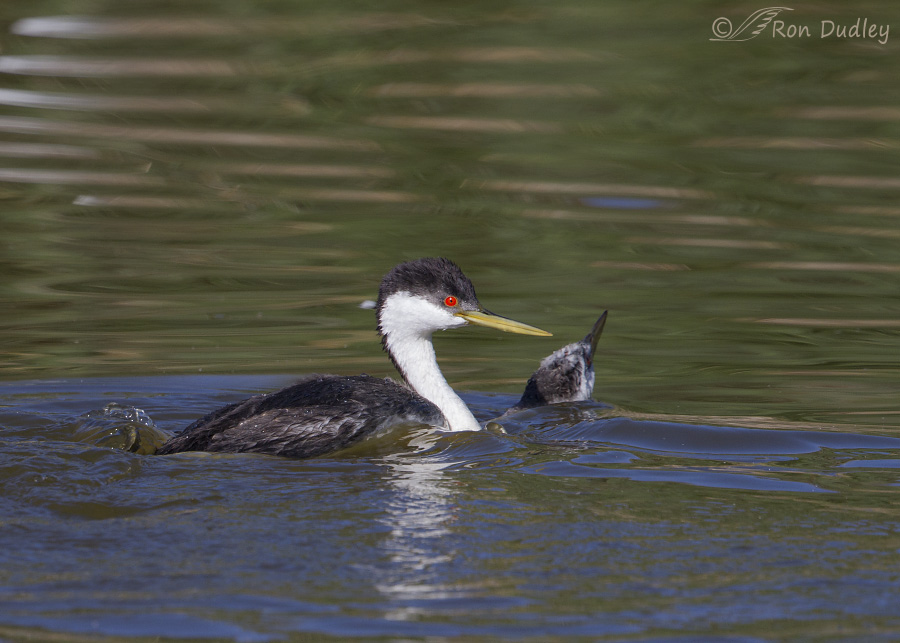
1/2000, f/6.3, ISO 400, Canon 7D, Canon EF 500mm f/4L IS II USM + 1.4 tc, not baited, set up or called in
The weight of the very large young bird forced the adult underwater except for its head and neck. What appears to be the body of the adult is really that of the juvenile.
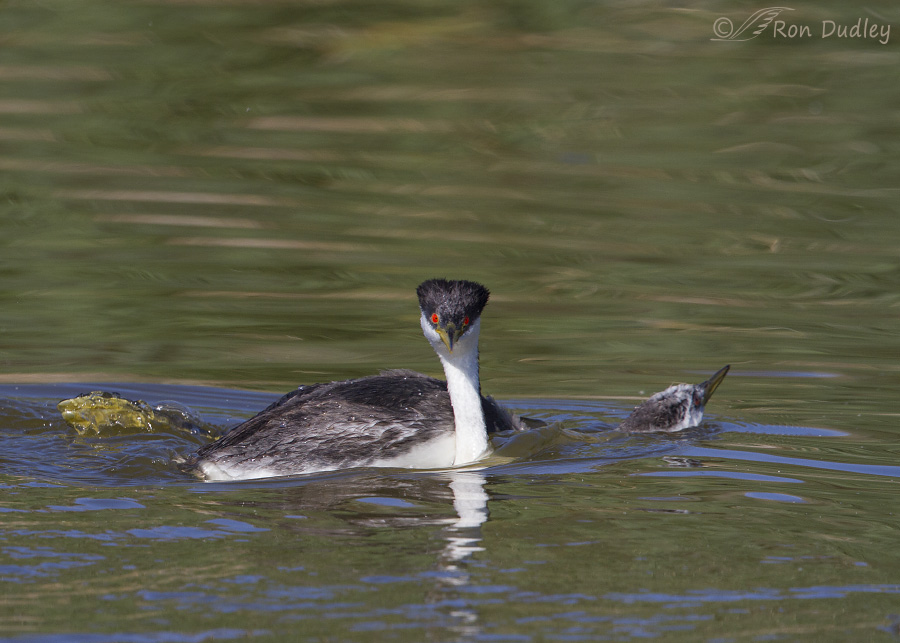
1/2000, f/6.3, ISO 400, Canon 7D, Canon EF 500mm f/4L IS II USM + 1.4 tc, not baited, set up or called in
But the adult was having none of it – this youngster is just too damned big for back-brooding. Here we see the foot of the adult (juveniles have darker feet) being used to…
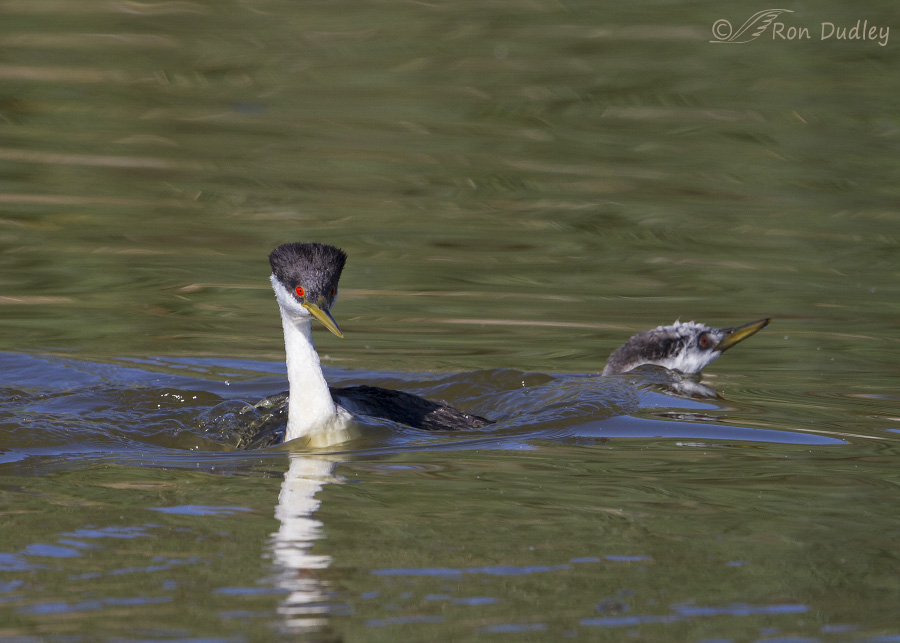
1/2000, f/6.3, ISO 400, Canon 7D, Canon EF 500mm f/4L IS II USM + 1.4 tc, not baited, set up or called in
make a quick turn to its right which forced the juvenile off its back and dumped it back into the water. At this point the young bird gave up and continued to swim away.
I can only believe that this was an attempt by the juvenile to be back-brooded long after it was appropriate or even possible. There were several aspects of this behavior that were new to me and I’ve spent hundreds of hours watching back-brooding grebes.
- I’ve never seen a juvenile anywhere near this large attempt to climb onto the back of its parent.
- In my experience chicks always climb on board from the rear of the parent (sometimes using the deliberately outstretched foot and leg of the parent as a “ladder). This somewhat sneaky approach to boarding was new to me.
- When they’ve had enough of their passengers parent birds usually dump their chicks back into the drink by raising up vertically and flapping their wings. I thought this quick maneuver in the water was a novel but necessary approach, given the size of the youngster.
This was a completely unexpected behavior and it was fun to document it with photos. You just never know what you might see if you spend enough time watching birds.
Ron
Note: Optical illusions can be both transitory and selective in who they work for. If you weren’t fooled by the first image I’d be interested in knowing it.


Fantastic series Ron!
Charlotte Norton
Once again you were in the right place at the right time to capture some really interesting behavior! And since I’ve never seen a Western Grebe I am not too disturbed by being forced to view two (gasp!) consecutive posts of these beautiful creatures.
As far as the behavior being unique – nah. My kids are over 40 and STILL try to sneak onto a lap. Durn young’uns.
I have to keep reminding myself that some folks don’t see this species, Wally. They’re very common around here in the summer.
Definitely fooled. Which is nothing for anyone (avian or not) to be proud of. It is NOT a difficult task.
Fooled, and intrigued.
Yet another behaviour which crosses species. Kangaroo offspring climb into the pouch when they are waaaaay too big for it. The original pouch potatoes. And some humans too…
“Pouch potatoes” – That’s a new one for me, EC. Like it a lot. A good point you make, too.
Love them all!! Thank you for being there and sharing!
Thanks, Pat.
That’s quite the illusion, OK!
Sounds like it worked for you, Patty!
Do you really think we’re that gullible? It is obviously one of those double-headed grebes. The amazing thing is that the heads seem to be different ages…I don’t really understand how that is possible, but apparently it is….
I get so involved watching behaviors I forget to take photos. Even when I am watching through the lens of my camera.
That has almost happened to me too, April.
WOW! I just love the behavioral shots, documenting stuff that most folks would think doesn’t ever happen and/or is impossible. With this series, all you can say is KIDS! LOL! Once again, thank you!
Glad you enjoyed it, Laura. Thanks.
Fantastic behavioral series, Ron. Love the “grebe twofer”!
Thank you, Diane.
How fun! 🙂 One does have to look closely to figure it out! Adult looks quite annoyed in the 2nd to last photo. 🙂 Thx for sharing, Ron! 🙂
I think the adult looks nonplussed and a little cross-eyed in that shot, Judy.
This is the most amazing series of photos! My husband and I were both certain of what we were looking at in the first one, until we saw what really happened. The series had both of us laughing. You’ve pointed out before that Grebe chicks are very demanding. I think this chick is the most demanding of all. It brings to mind the song that says, “I don’t wanna grow up…”
I’m glad you found the behavior (and the illusion) as interesting as I did, Susan. When this happened in the field I remember saying out loud in the middle of the burst I was firing – “Wow, I’ve never seen THAT before”. But I didn’t know about the illusion until I looked at the photos.
Excellent behavioral shots Ron.
Sorry, wasn’t fooled.
Adults don’t contort like young do.
Thanks, Dick. And don’t apologize – sometimes illusions work for folks and sometimes they don’t. Thanks for the feedback.
So, so interesting, Ron. Thanks for documenting these moments that the vast majority of us will never have the opportunity to see in person. I always enjoy beautiful pics of birds and nature, but when they involve an unusual behavior, it makes them all the more appealing.
Thanks very much, Gretchen. It sounds like you enjoy behaviors as much as I do!